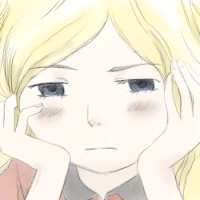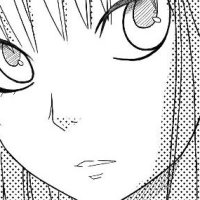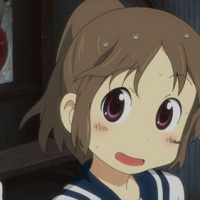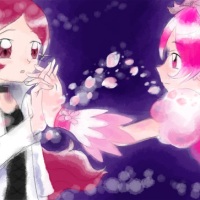Airing in 2012’s summer season for thirteen episodes, Dog Days’ (pronounced [dɒɡ deɪz dɑːʃ]) is the sequel to 2011’s fantasy action/adventure series, Dog Days. It follows the adventures of a young boy in a fantasy world, later accompanied by his cousin and childhood friend.
Both series are relatively mediocre, with uneven plots, one dimensional characters, and concerts that make for a poor man’s idolm@ster. Yet that the original was popular enough to warrant a sequel, suggests it very much a guilty pleasure.
Whilst this may very well be the case, the series has previously attracted attention on two specific elements. That war is waged without bloodshed has been explored by ToastCrust, and the pastry-inspired naming convention has been noted, amongst others, by Marina. Here, we will comment upon the series’ setting, heraldry, and role playing game (RPG) elements.
As with any fantasy series, setting is important. A world must follow its own rules, and those rules be consistent with one another, lest it fail before it has even begun. The main focus of Dog Days lies with two, later three, countries on a single content. The Biscotti Republic, The Principality of Pastillage, and Galette Lion Territory are each loosely based on medieval European countries, with levels of technology similar to our own.
The world itself provides for the series’ central conceit and technological level. Magic, known as Fronya in-series, pervades the world; acting as a protective buffer and a shapable force. Fronya, the series illustrates, is powerful enough to support floating castles and magical beings both. Whereas the former is somewhat expected, the latter, alongside a number of humanoid spirits and demons, suggests the possible origins of the world’s general populace.
The series also illustrates that Fronya is neither infallible, nor omnipresent. The existence of demons, effectively fallen ‘earth spirits,’ are proof of this. The first series uses this infallibility as the reason behind its climax. It is then explored again in the sequel, in the form of both unhappy local ‘earth spirits’ causing trouble in a village, and the introduction of the Demon King and his duties. Whilst the former calls to mind Hayao Miyazaki’s Princess Mononoke, albeit on a smaller and less well executed scale, the latter suggests an interesting, complex world that the audience has yet to fully see. In short, such infallibility, in an otherwise sugary world, makes for a fascinating, if underused, setting.
In many fantasy series, with both feudal societies and an active magic system, magic is commonly found within discrete individuals or items. The magic system in Dog Days however, presents an awkward juxtaposition. The nature of Fronya, where anyone might shape it through concentration, is surprisingly open for such a series. Yet its use remains the preserve of the nobility. Furthermore, this does not arise through any observable enforcement by the nobility itself. The connection is only further amplified by the magic circles formed when casting.
Rather than the typical warm glow of floating geometric shapes and runes, Dog Days favours similarly glowing coats of arms; with the size and detail of the arms indicating the strike’s intended magnitude and complexity.
The heraldry introduced remains very much in the same vein as the vaguely European setting, yet that it is used in this manner is interesting. Though mostly pertaining to the prince and princesses in the series, the coats of arms are sometimes worn in the traditional manner. Thus, and alongside other hints such as the Martinozzi siblings using the same crest, it is not unlikely that the arms are deliberately designed, and not generated automatically upon first use.
Hence, we find a magic system that is at the same time both open, and limited to the nobility. Again, and if handled well, further exploration would not necessarily be unwelcome.
Anime finds its inspiration in many places, some have their roots in light novels and manga, others from games, and others still are original stories. Whilst not quite as successful as other anime originals, Dog Days is one such series. Yet it exhibits a number of elements and systems that are seemingly inspired by the common RPG. Elements such as the magic system discussed above, the battles’ extensive coverage and format, and most interestingly, the character classes exhibited.
To explore the concept of character classes a little, we must return to the three countries. Galette is shown to favour overwhelming use of infantry and chocobo-cavalry. Biscotti has a more balanced strategy; using infantry and chocobo-cavalry alongside long-ranged archers and gunners, with a small air force to compliment. Conversely, Pastillage relies heavily on long-range aerial and magical assault. Each of the main cast reflects these specialities. The countries’ champions, the summoned Heroes, also appear to be based on typical character classes, and an extension of their adoptive country’s overarching tactics. Both Biscotti and Galette’s champions focus on mêlée combat, and each is aligned with a particular element; these being fire and water respectively. Pastillage’s champion is a mage-type, using spell cards similar to those found in the Touhou universe. The class of Pastillage’s champion however, is more notable than either Biscotti’s or Galette’s in this regard, as the First Princess of Pastillage explicitly mentions this in the second episode of the second series.
The use of RPG elements is not necessarily a bad thing, however. These elements were not the sole preserve of the humble RPG after all, and when handled with care, and not used as a character’s sole defining trait, act as a shorthand for the viewer. They are simply another tool to use, akin to more general character archetypes. Indeed, a number of series of late appear to have incorporated such elements; Puella Magi Madoka Magica and Magical Girl Lyrical Nanoha being just two.
Whilst guilty pleasures are often dismissed as mindless fun, and indeed they are for the most part, such series are still likely to hold some merit. Dog Days is a mediocre series. Yet the world in which it is set, its magic system, art of war, and naming convention are each interesting for their own reasons. Anime as a medium, is primarily a form of escapism, with only the occasional gem hidden in the mire. Whilst Dog Days is exemplary of a series resting contentedly with the majority, it offers a hint of imagination in its setting and though this might be unpolished, the potential remains.
Further Reading:
Dog Days and False Warfare – Mentioned previously, ToastCrust discusses the art of war in the series.
The Pastries and Confections of Dog Days’: Biscotti, Galette, & Pastillage – Marina takes a brief look at the naming convention within the series.
Thinking Points (VII) – Hades Project Zeorymer and the Right Way to Like Bad Films – Webster looks at guilty pleasures, and the appreciation of them.
I Got My Wife to Watch Anime With Me Again. Unfortunately, it’s Beelzebub – ghostlighting looks at justifying our embrace of mediocrity; beware the screenshots.
Dog Days – Aroduc’s episodic reviews of both series.














I think you’re trying to hard to justify a guilty pleasure. Believe me, if you could justify it, it would no longer be a guilty pleasure.It’s simply that sometimes even the most analytical anime viewer needs to take a break. Watch what you enjoy; that’s all that matters. It might be best to just leave the explanation at that.
You’re probably correct in that I’m trying much too hard to justify my watching this series, and I will certainly admit that Dog Days was a break, a series to which I could simply escape over a busy summer. Having said all that, I still believe that there is something to examine in any guilty pleasure; RP Webster’s link in the bottom section explains this better than I probably ever could. For me, and in Dog Days, that was the setting. The world they, alas, only partly develop, had a certain spark that made me want to explore it more. Especially that of the style of government in the three countries.
But anyway, I thank you for the comment. It is much appreciated.
I felt that both series were charming enough to give a watch. My spawn loved the entire run, however they did note that Dash was more like “The Picnic Anime”, with the complaint that they more or less just hung out and “wuved” each other.
I tend to agree, it’s not the most original world but it had some promise that Dash squandered for a weak tea character narrative.
But then, I love guilty pleasures.
‘My spawn loved the entire run, however they did note that Dash was more like “The Picnic Anime”, with the complaint that they more or less just hung out and “wuved” each other.’
You have some fine ‘spawn’, if I may so. ^ ^
In a (ever so slightly) more serious tone, I certainly agree. They were charming and harmless. They were fluff, but earnest fluff. That is not always a bad thing, nor is the occasional indulgence in a guilty pleasure.
I thank you for reading, and the comment too. It made me smile.
I’ll pass along the compliment, next time they swim upriver….